The caves of Copernicus
and the Ocean of Storms
The discovery of new caves on the Moon keep coming. Today I have two new stories. The first is a discovery by professional scientists of a giant lava tube cave in the Oceanus Procellarum or Ocean of Storms. The second is the detection of a plethora of caves and sinks on the floor of the crater Copernicus, found by a NASA engineer who likes to explore the gobs of data being accumulated by Lunar Reconnaissance Orbiter and made available to all on the web.
The image below of the Moon’s near side, taken by India’s Cartosat-2A satellite and taken from the science paper, shows the location of lava tube in Oceanus Procellarum (indicated by the red dot) and the crater Copernicus.
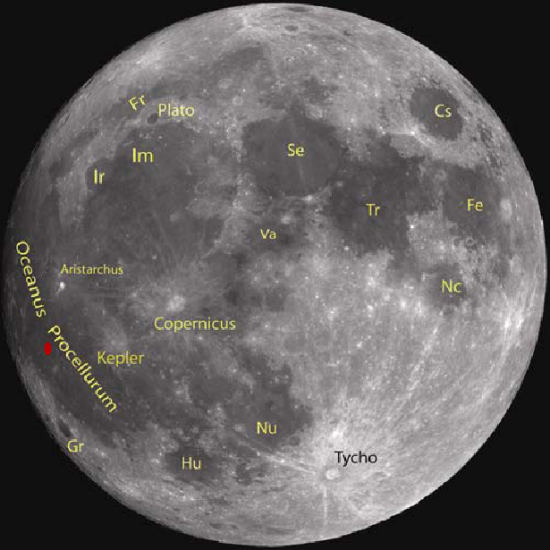
First the professional discovery. Yesterday, the Times of India reported the discovery of lava tube more than a mile long on the Moon. I did not post a link to the article because I didn’t think the news story provided enough information to make it worth passing along. Today however, fellow caver Mark Minton emailed me the link where the actual research paper could be downloaded [pdf]. This I find definitely worth describing.
Using data and images produced by Chandayaan-1, India’s first lunar probe, scientists from the Indian Space Research Organization (India’s NASA) were able to map out the size and make-up of a very huge lava tube, located on the near side of the Moon in the equatorial regions of the mare region known as Oceanus Procellarum, or the Ocean of Storms, where Apollo 12 landed in 1969. Below is a computer generated image from their paper showing the rille and lava tube as if you were flying over it in a plane. The downward slope of the tube is towards us. Note also that the vertical relief is exaggerated 1.5 times.
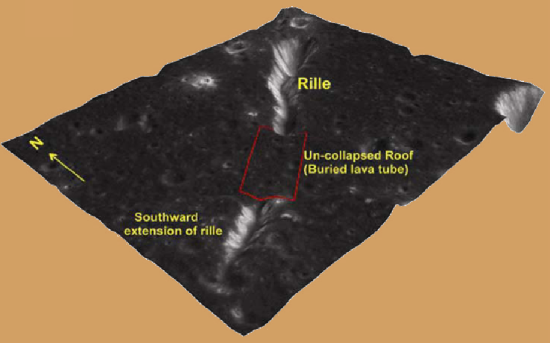
This lava tube is big. The length of the uncollapsed section is estimated to be just over one mile, with an interior cross-section from 500 to 1200 feet across. The roof itself is estimated to be more than 200 feet thick, which not only makes it structurally sound, it provides ample protection from radiation for anyone inside the tube.
Other data shows the surface regions around the rille as being rich in titanium, while the bottom of the rille itself is rich in iron. Both ores will be useful to future colonists.
The second set of new cave discoveries once again comes from NASA engineer James Fincannon, who has previously emailed me other images of lunar caves he has discovered by data-mining the images available on the web from Lunar Reconnaissance Orbiter. In this case, James did a survey (not yet complete) of the floor of the crater Copernicus, and came up with three (possibly four) caves plus another five sinkholes or collapse features that suggest there are additional underground passages with no known visible entrance.
Below is an image of the floor of Copernicus with these caves and sinkholes indicated. Their scattered locations are somewhat random, which could either suggest their formation is random, or that we haven’t yet found enough of them to give us a full idea of the overall system of underground passages under Copernicus’s floor. Note also that all of these features are small, though the exact dimensions have not yet been calculated. They are definitely too small to see in the index image below.
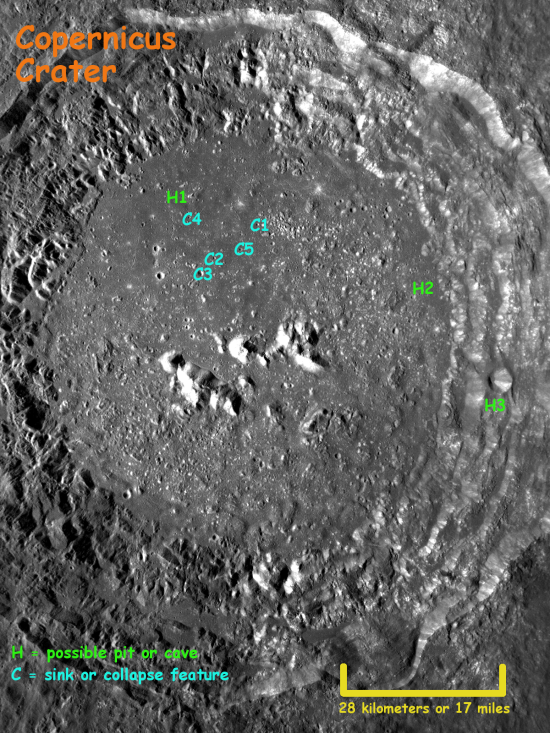
The two images below show the cave dubbed H1 at two different times, once when the Sun was high in the sky (left) and again when the Sun was closer to the horizon and the shadows were longer (right). Note the boulders at the bottom of the pit.


The resolution of the image for cave H2 (on the left) is not as good. Also, James has not yet found another image of this cave taken at a different time. Still the shadows suggest the pit walls are overhung, and there might be passage extending away below. One thing to note: a wider view shows no surface collapse features or rilles, which suggests there might not be a lot of cave passage at the base of this pit.
More data is obviously needed.
Next we have two images of Cave 3 (below), both with the Sun relatively high in the sky. The first has the sunlight coming from the left, the second coming from the right. Both images suggest that this is a relatively shallow pit. Both also suggest that there might be an overhang or additional passages under the left wall.
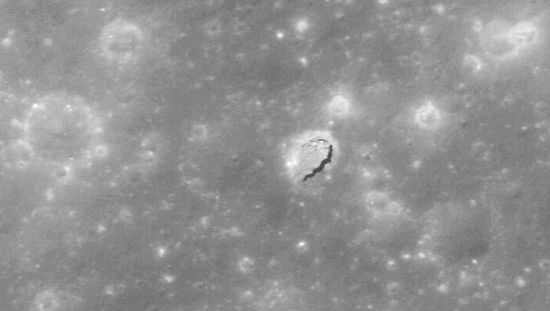
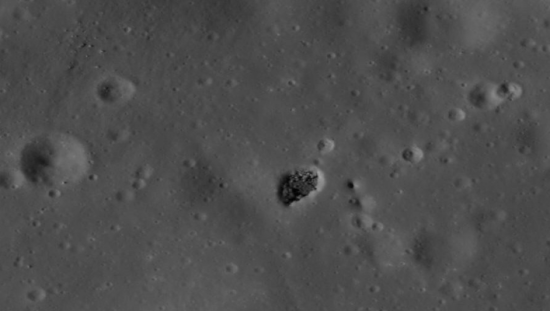
Those are the possible caves. The third is interesting in that is is actually not on the floor of Copernicus, but up on its eastern rim. I will leave it to the geologists to explain the differences.
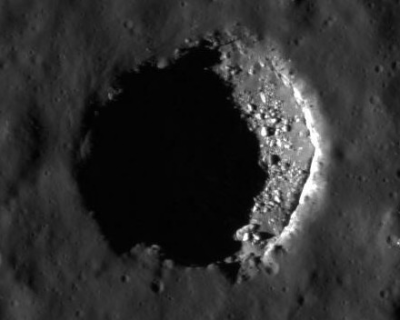

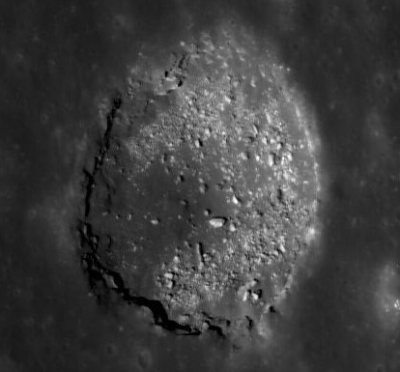
In addition, James found what appear to be five additional collapse features or sinkholes, all of which suggest that there are passages below.
On the right are three images of C1. The first is with sunlight coming from the left at a low angle. The second has the sun higher in the sky. The third the sun is even higher, with the angle of view more from the side rather than overhead.
The sink is relatively shallow with its floor littered with boulders. Though the walls of the sink, especially the right wall, appear vertical, the material inside looks like it is filling in a much deeper hole.
It is possible that this is an impact crater that has gotten filled in with material over time. To my eye, however, it looks more like the surface collapsed downward, filling in the void below.
Scroll down for more images, with the text below the images.
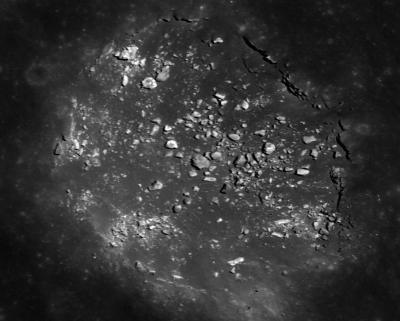
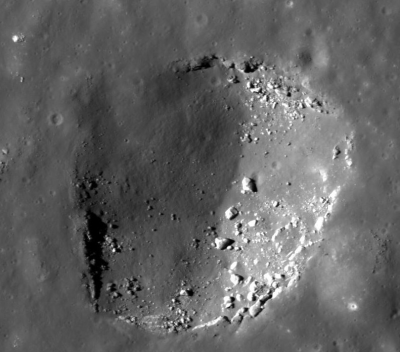

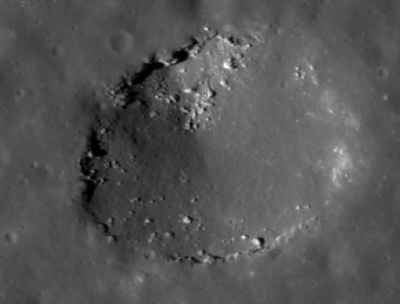
These last four sinks above, C2, C3, C4, and C5, are all very shallow and all appear to be filled partly with lunar dust. In fact, the dust almost appears to have been windblown into the sinks, something that is patently impossble on the Moon. Regardless, all resemble collapse features or sinks, and suggest there are voids below.
Obviously, a more complete survey of the floor of Copernicus would be helpful. By getting a more complete idea of the location of all the sinks we would get a better idea of the overall pattern of underground passages, which in turn might help explain the formation process that produced the caves. And that formation process, while having some similarities to lava tube formation on Earth, has to have significant and fundamental differences. For one thing, the gravity on the Moon is far weaker. Furthermore, because the caves formed on the floor of a gigantic impact crater one wonders whether they formed immediately after the impact, or much later.
One last thought: Bill Stone, the cave explorer who is putting together a company to mine the Moon for fuel and profit, noted to me in an email that “the problem, of course, is that none of [these caves are] in a locality of interest…. i.e. the polar regions.” He also agreed that “I’ll take what we can find when we get there.”
The more of these underground voids we find, the more likely we will understand their formation, and the more likely they will be found in places we would like them to be. We might even find that there is no need to depend on the lunar poles for building our future Moon colonies. As noted by the Indian scientists in their paper on the lava tube in Oceanus Procellarum,
Lava tubes provide a natural environmental control with a nearly constant temperature of –20°C, unlike that of the lunar surface showing extreme variation, maximum of 130°C to a minimum of –180°C in its diurnal cycle. Lava tubes offer a dust-free environment, which is also an essential condition. In addition, adapting lava tubes for human use requires minimal construction, effectively and economically. Another idea proposed is that the sheltered environment and consistently cold temperatures in the lava tubes may serve as a trap for water ice and other volatiles. [emphasis mine]
In other words, though the lunar poles are presently the hot real estate because we have found significant evidence of a lot of water-ice there, it is possible that water-ice might also be trapped inside caves in lower latitudes.
On Christmas Eve 1968 three Americans became the first humans to visit another world. What they did to celebrate was unexpected and profound, and will be remembered throughout all human history. Genesis: the Story of Apollo 8, Robert Zimmerman's classic history of humanity's first journey to another world, tells that story, and it is now available as both an ebook and an audiobook, both with a foreword by Valerie Anders and a new introduction by Robert Zimmerman.
The print edition can be purchased at Amazon or from any other book seller. If you want an autographed copy the price is $60 for the hardback and $45 for the paperback, plus $8 shipping for each. Go here for purchasing details. The ebook is available everywhere for $5.99 (before discount) at amazon, or direct from my ebook publisher, ebookit. If you buy it from ebookit you don't support the big tech companies and the author gets a bigger cut much sooner.
The audiobook is also available at all these vendors, and is also free with a 30-day trial membership to Audible.
"Not simply about one mission, [Genesis] is also the history of America's quest for the moon... Zimmerman has done a masterful job of tying disparate events together into a solid account of one of America's greatest human triumphs."--San Antonio Express-News


Wow. These things look like a massively valuable resource for future manned missions. I’m thinkin we need to flood the moon with a legion of robots to start exploring and assessing these formations. Small, interconnected rovers?